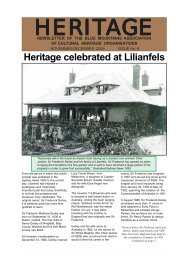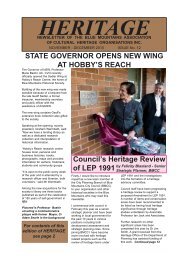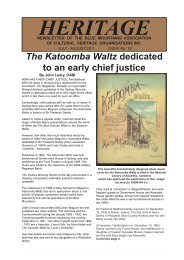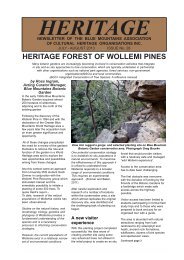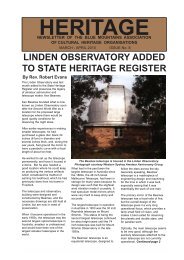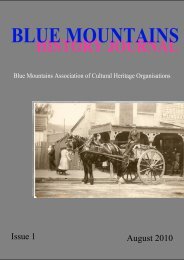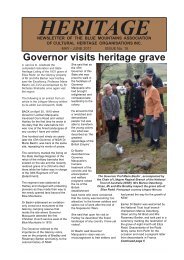Blue Mountains History Journal Issue 3
Blue Mountains History Journal Issue 3
Blue Mountains History Journal Issue 3
You also want an ePaper? Increase the reach of your titles
YUMPU automatically turns print PDFs into web optimized ePapers that Google loves.
<strong>Blue</strong> <strong>Mountains</strong> <strong>History</strong> <strong>Journal</strong> 3: 2012<br />
Figure 2. William Dymock’s 1810 map of the settlements (Dymock 1810).<br />
A series of maps produced<br />
in 1810 ‘by order of the<br />
government’ variously by<br />
John Booth, Robert Rowe<br />
and William Dymock<br />
indicate that the <strong>Blue</strong><br />
<strong>Mountains</strong>, described as<br />
“successive immense<br />
ridges”, lay along the parts<br />
from west of the Nattai<br />
River in the south, almost<br />
to the Colo River in the<br />
north. However, given<br />
that that was the extent of<br />
the maps, it is not to be<br />
assumed that the <strong>Blue</strong><br />
<strong>Mountains</strong> were not<br />
considered more extensive<br />
(Dymock 1810). (Figure<br />
2).<br />
Blaxland, Wentworth and Lawson<br />
Despite the entrenched narrative which holds that Blaxland and friends completely crossed the <strong>Blue</strong><br />
<strong>Mountains</strong>, the men themselves did not at the time claim to have done so. While Blaxland’s journal<br />
declares that the purpose was to<br />
“effect a passage over the <strong>Blue</strong> <strong>Mountains</strong>” (Richards 1979, p.67),<br />
the outcome of the expedition, according to the same journal, was simply that<br />
“... they had sufficiently accomplished the design of their undertaking, having surmounted all the<br />
difficulties …” (Richards 1979, p75).<br />
Wentworth admitted<br />
“... we have not actually traversed the <strong>Mountains</strong> [though] we have at all events proved that they are<br />
traversable …” (Richards 1979, p114).<br />
Macquarie at first evaded the question, in the one document declaring that the trio had<br />
“... effected a Passage over the <strong>Blue</strong> <strong>Mountains</strong>, ...” (Macquarie in Campbell 1814, col.2),<br />
and that he had sent George Evans<br />
“... to discover a passage over the <strong>Blue</strong> <strong>Mountains</strong>, ” (Macquarie in Campbell 1814, col.1).<br />
It was only while he himself was making the journey to Bathurst in 1815 that he decided to set the<br />
goalpost at Mount York, which, although being the point where he found himself descending from the<br />
sandstone plateau, is well short of the watershed of the Great Dividing Range to the west. He wrote in his<br />
journal:<br />
“Here we halted for a little while to view this frightful tremendous pass, as well as to feast our eyes<br />
with the grand and pleasing prospect of the fine low country below us and now in view from this<br />
termination of the <strong>Blue</strong> <strong>Mountains</strong>” (Macquarie 1815, 29 April 1815).<br />
This has come to be relied on as proof that the explorers completed the crossing of the <strong>Blue</strong> <strong>Mountains</strong><br />
when they descended from Mount York. One prolific historian has cited it as evidence that Macquarie’s<br />
divine service at Coxs River was the first held to the west of the <strong>Blue</strong> <strong>Mountains</strong> (Havard 1935, p.70).<br />
5




